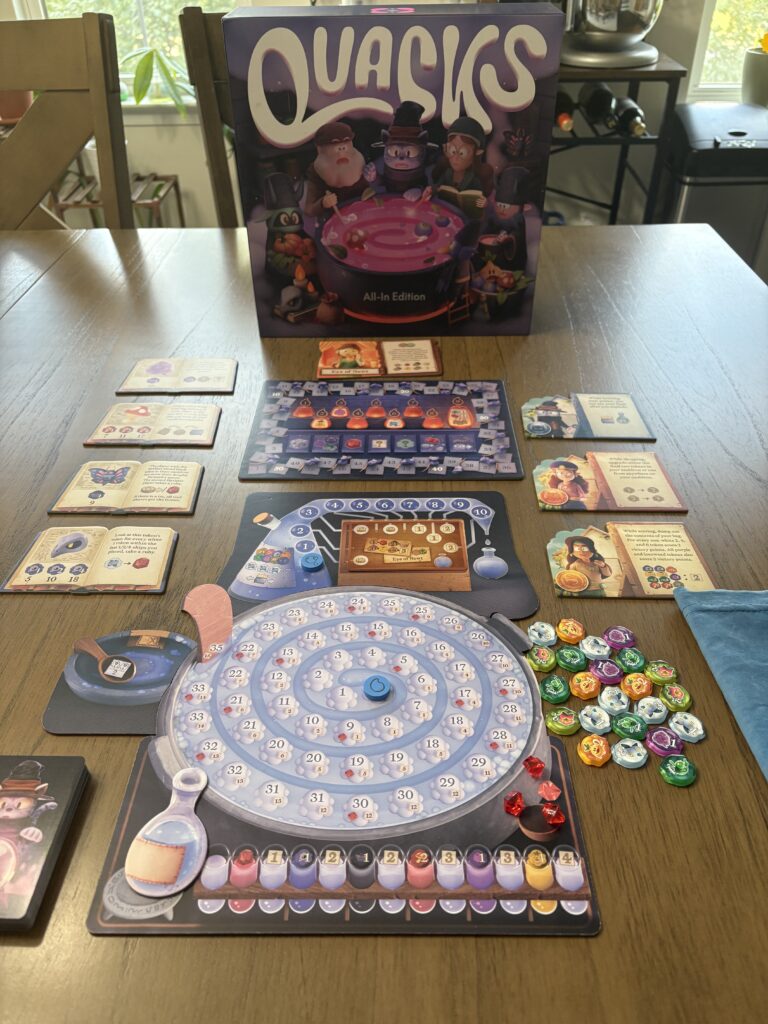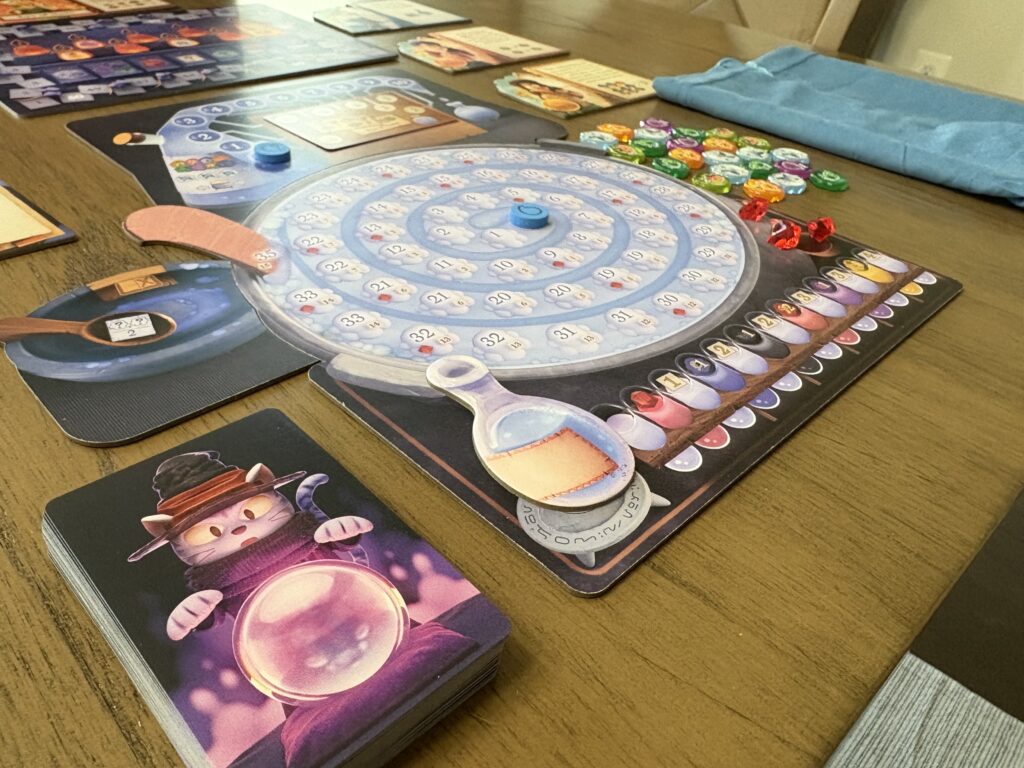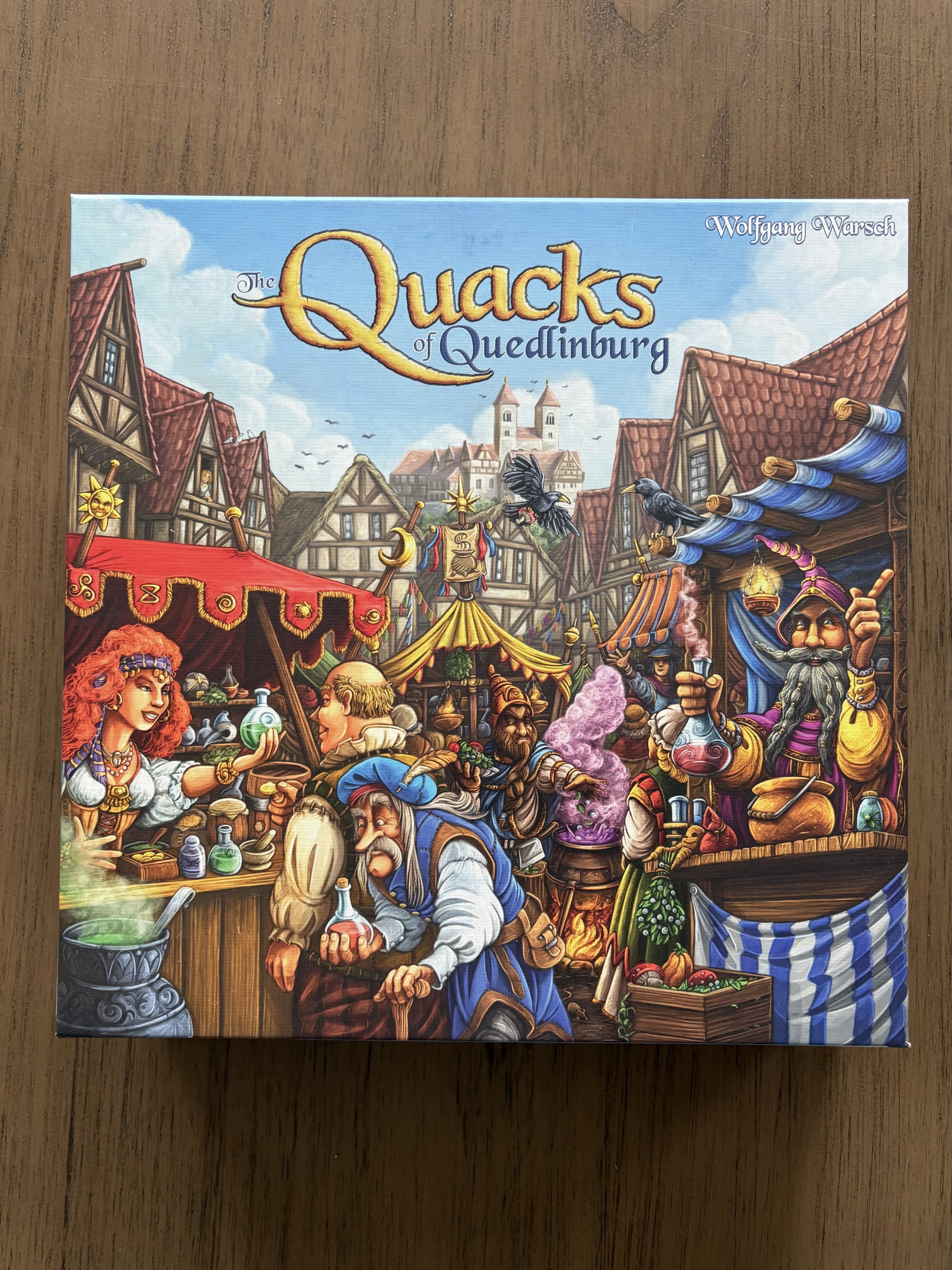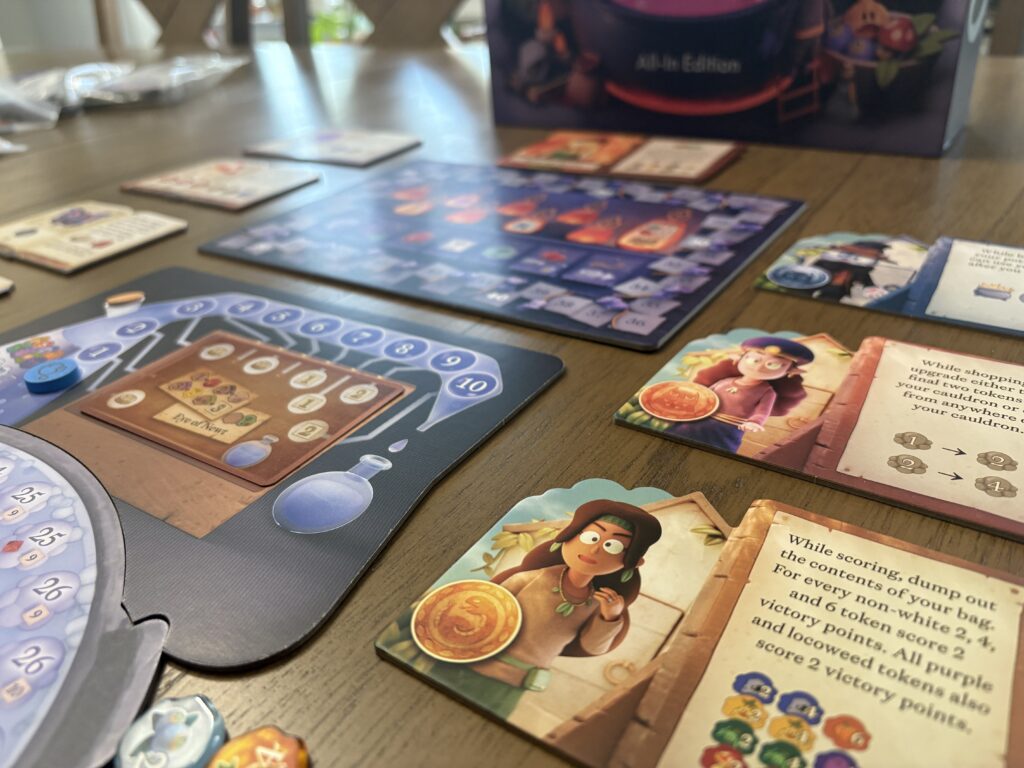Welcome to this week’s review! This week I’m taking a look at the new edition for one of my favorite gateway level games. So without further ado, let’s jump into it.
Disclosure: A review copy of this game was provided to The Meeple Digest in exchange for an honest, unbiased review. This review is not intended to be an endorsement.
Quacks
- Designer: Wolfgang Warsch
- Publisher: CMYK
- Complexity: Light
- Time: 45 Minutes
- Players: 2-4
- Main Mechanisms: Push-Your-Luck, Bag-Building
The Quacks of Quedlinburg, or now known as just Quacks, is a push-your-luck game where players simultaneously draw tokens from their bag, increasing the value of their potion which is then used to determine the number of points that player will score each round, as well as how many coins they will have to spend on new ingredients to add to their bag for the next round. During a round, players continue to pull tokens from their bag until they either choose to stop or their pot explodes.

In the base version of Quacks, there are six different colored chips that each provide different effects when added to a player’s pot. For example, the green chip provides benefits at the end of the round if it was one of the last two chips drawn that round. In addition, five of the chip types have four different variations, and while the game recommends playing with playing with versions from the same set, you are also free to mix and match to create your own sets. This variety gives the game some nice replayability.
Quacks has consistently been one of my favorite games to teach to new gamers. It’s a relatively light teach, and I can choose to use a less complex chip set when teaching to new players. In addition, the simultaneous turns reduces the amount of downtime, keeping players engaged and making sure the game doesn’t drag.
Speaking of game length, the game does toe the line for how long a game like this should take. With four players, games will likely take around an hour, if not a bit longer since there are nine rounds in the game. I almost wish there was a quick-start option where you could add a few extra colored chips to your bag during setup, and then you could potentially shorten the game by a round or two.

Another thing to note is that the game does have a high luck factor. Yes, there is some strategy around deciding which chips might combo well together, but at the end of the day, a lot of the game boils down to which chips you draw. Even when the odds are stacked in your favor, sometimes you can just have bad luck. To get the most enjoyment out of this game, you have to accept that there is a high degree of luck involved. I can understand how that might turn some types of gamers away; however, as long as players don’t take the outcome too seriously, the gameplay itself can bring plenty of laughs.
Similar to the amount of randomness, if you struggle during the early rounds, it can be difficult to catch up. The game does provide a catch-up mechanic that allows you to effectively start further ahead in your pot based on how many victory points you are behind from the leader. However, the bigger issue is that early poor rounds can mean that it’s more difficult to fill your bag to decrease the odds that you will bust in later rounds. Therefore, I’ve had a few games where it can feel like players are effectively going through the motions, knowing that they are too behind to realistically have a chance to catch up and win. Again, if the game was slightly shorter, I think this would reduce the issue.
How does the new version compare to the original?


One problem with the original version of Quacks is that since were chips cardboard tokens, if you played the game often enough, the artwork on the chips would start to noticeably wear. Therefore, it was fairly common to see gamers buy coin capsules or GeekUp bits like these to upgrade their version. I’ve likely played my original version close to ten times, and while I didn’t notice much wearing on the majority of the chips, the white tokens were the most noticeably worn since they were used the most. As far as I’m aware, the base version of this new edition still has cardboard chips, but the Deluxe and All-In editions both come with bakelite-style tiles for the chips instead of cardboard tokens. I’m not usually one to deluxify my games, but I have to admit, the new tiles are a considerable upgrade and should prevent any worry about the chips wearing.
Speaking of, I appreciate that there are multiple versions of the game now that allow for different price points. Although, it feels like a bit of a shame that you are not able to purchase the expansions separately, meaning that you would need to purchase the entire All-In edition to get the additional content. However, word is that CMYK might reevaluate this strategy if there is enough demand for the expansions on their own. That makes it difficult to recommend purchasing the more expensive All-In edition unless you already enjoy the game and/or are worried about missing out on content.
Putting the new edition of Quacks side-by-side with the original, the most obvious difference is the art style. There has been plenty of debate on which one people prefer; now having been able to compare both in person, I’m personally impartial to the change. The original version certainly had its charm, but some common complaints were that it was too busy. I’m personally surprised that they went in such a different direction, and Claymation style art is not something I naturally gravitate to, but the art isn’t bad by any stretch, and overall things are clearer to read. Overall, it feels like the new art is geared more to younger audiences.
How does the All-In Addition compare to the base game?
Now, moving on to what’s included in the All-In edition. The version includes the upgraded tiles and bags from the deluxe edition, as well as both expansions that were previously released: The Herb Witches and The Alchemists. As someone who had never played either of the expansions previously, I was very excited to jump into these.

The main part of The Witches expansion is the introduction of three different types of witches that give special abilities that can be used once during the game. The abilities don’t add too much additional complexity to the game, and I like how they add an additional layer of strategy and planning. There are also four versions of each of the three witch types which increases replayability.
The Witches also adds a new chip type, locoweed, which has an interesting mechanic where the value is determined by its ability rather than being fixed, as well as two additional sets of variations of the core chips from the base game. The Witches also adds an overflow bowl to your pot that allow you to score victory points even after reaching the end.
Finally, The Witches includes the ability to now play the game with up to five players. There are very few euro games that work well with five players; however, considering that a lot of this game can be played simultaneously, I would be open to playing this game at the full player count.
Overall, The Herb Witches is easy to include in pretty much all my games of Quacks going forward. It adds more variety to keep the game feeling fresh, without adding too much added complexity. Additionally, I think this expansion is light enough that I could probably include it even when teaching to new players; though, I do have the option of leaving out The Witches while still including the other parts of the expansion.
Moving onto The Alchemists expansion. The big addition in this expansion is an additional player board above your cauldron. At the end of each round, after finishing brewing your potion, you count the number of different colored tokens in your pot, as well as a couple of other modifiers. That value allows you to gain bonuses based on which of three different patients you chose during setup. An example is one patient allows you to draw additional chips from your bag at the end of the drawing phase and add them to your pot, without causing it to explode.
This expansion certainly feels like a step up in terms of added complexity; however, I do enjoy how it encourages you to diversify your strategy. For example, often in the base game of Quacks, you might focus on a couple of chip types that work well together and then spam them. With this expansion, you are rewarded with keeping your bag better-rounded. Overall, I like what this expansion adds, but unlike The Herb Witches, I likely won’t play with it in every game and certainly not with new players.
Outside of the new art style, the gameplay between the two editions are nearly identical. If you’ve never played Quacks and like push-your-luck games, then this is an easy recommendation. If you’re someone that already owns the previous game, then I imagine the decision will come down to whether you already own the expansions and/or have upgraded your components, as well as your opinion on the art style. Personally, the bakelite-style tiles and the expansions in this new edition make this an easy decision on which version will be remaining on my shelf.
With that, I’ll wrap up this week’s review! If you’ve played Quacks, I’d love to hear your thoughts on the game? While I don’t want to start a debate on the art, if you’re someone that already owns the old edition, will you be upgrading to the newer version? I’d love to hear your thoughts on any of the games I’ve mentioned or future content suggestions in the comments below. Happy gaming!
If you liked this post and want to be notified when new content is released, then follow me on Instagram @themeepledigest.